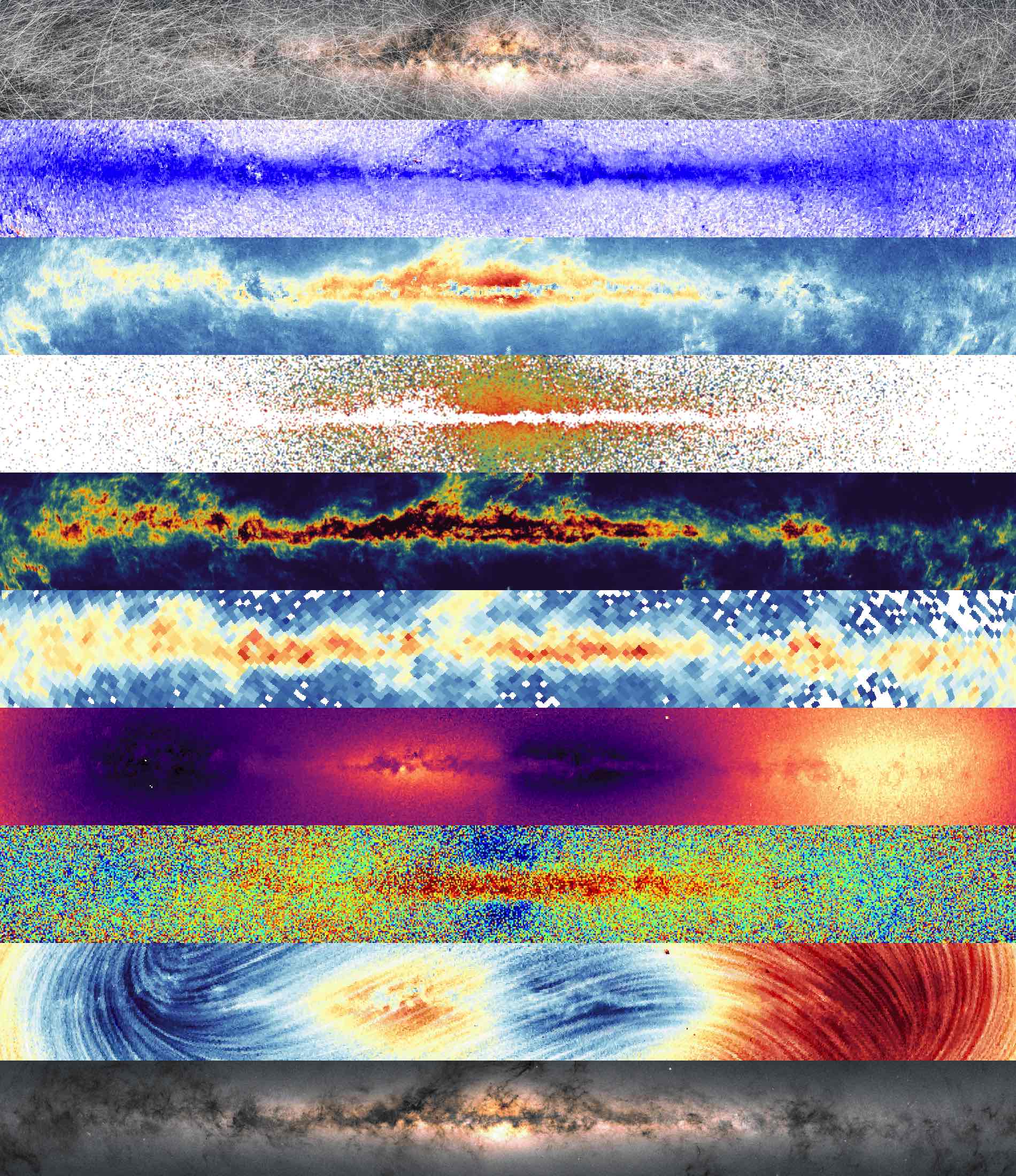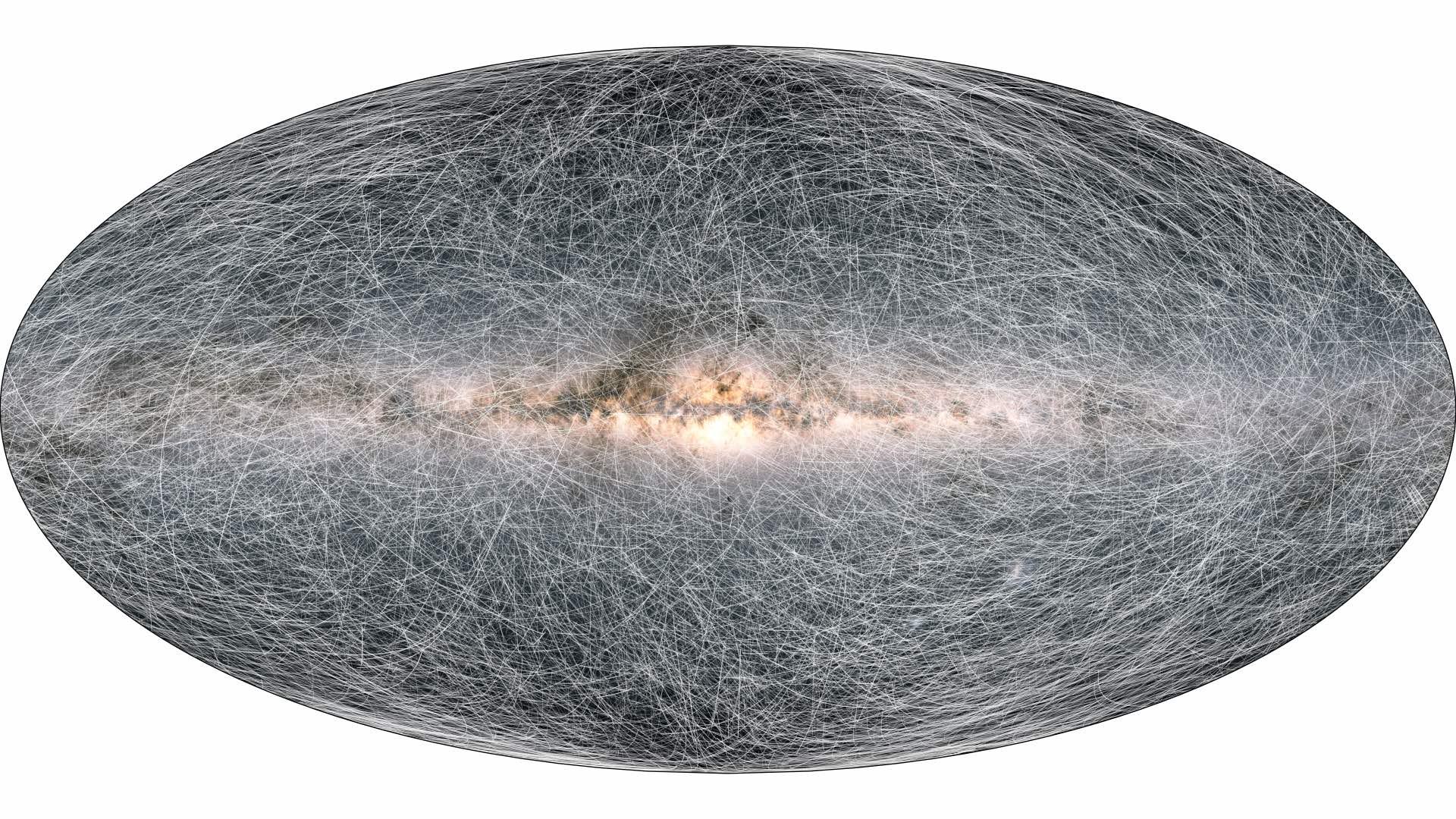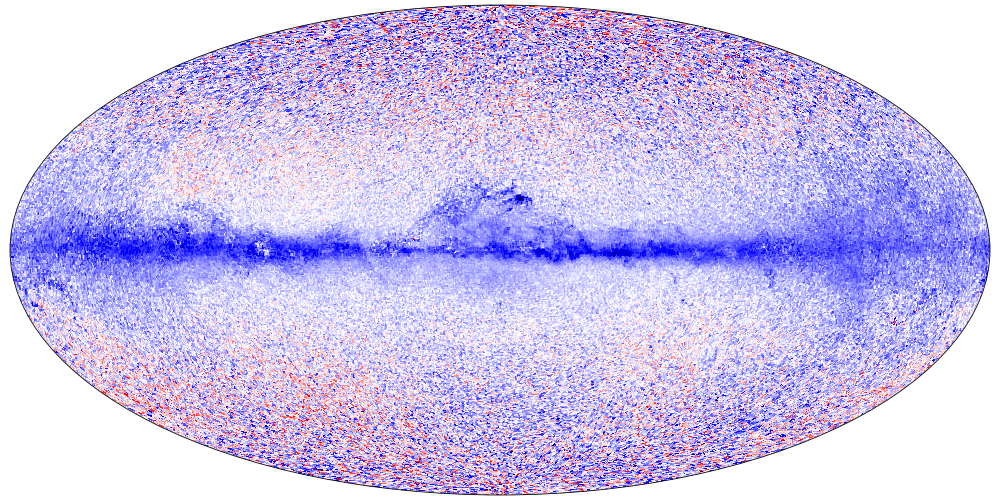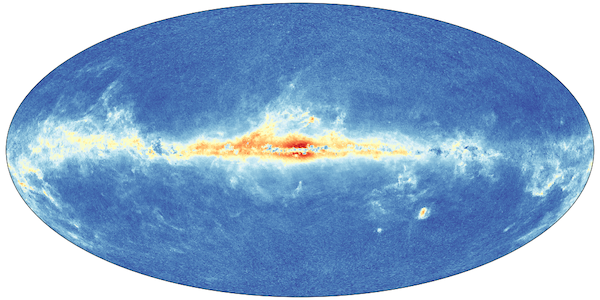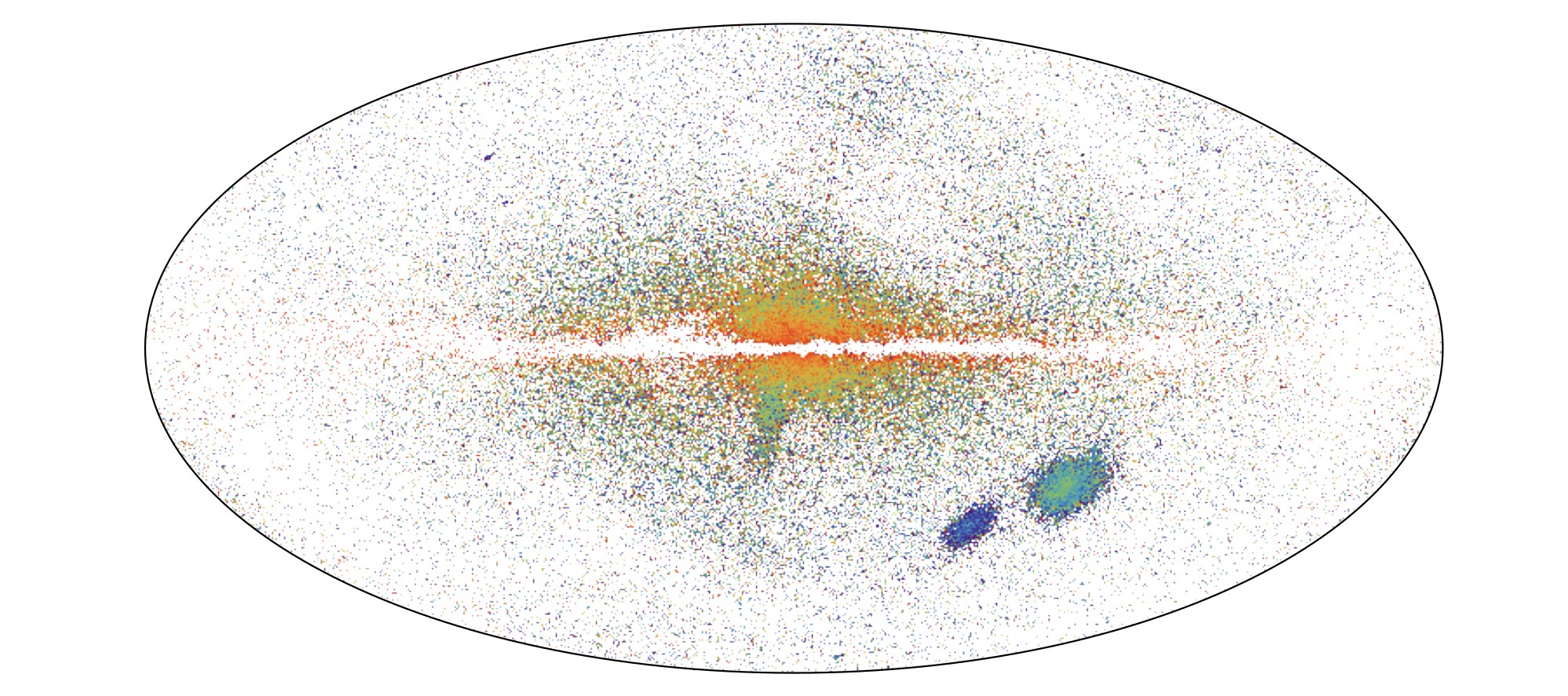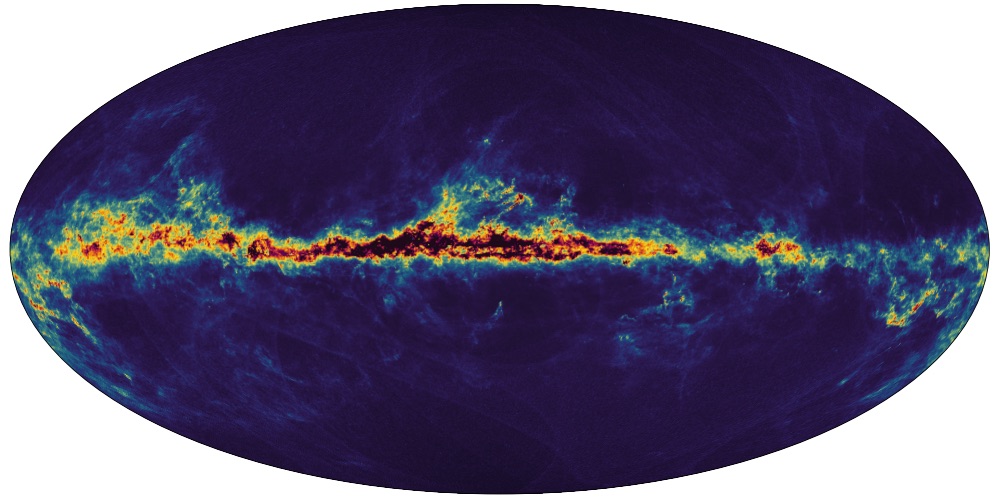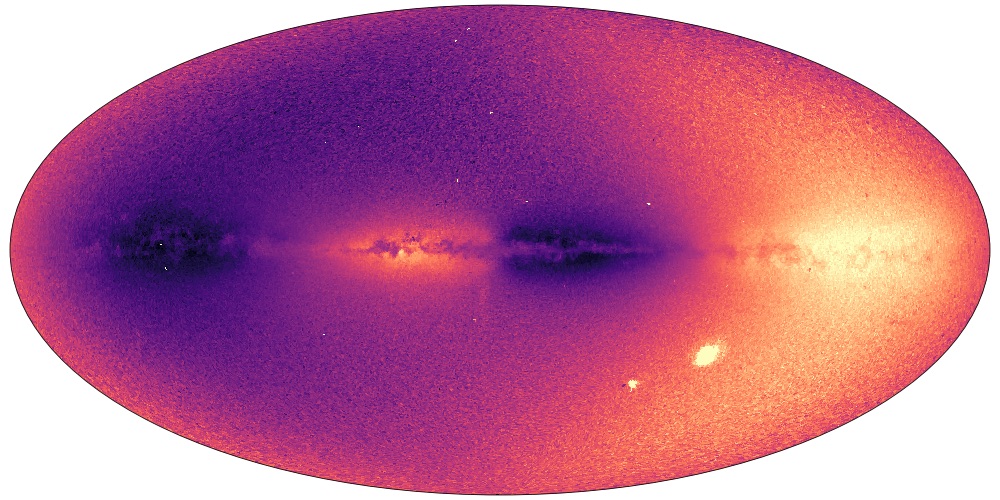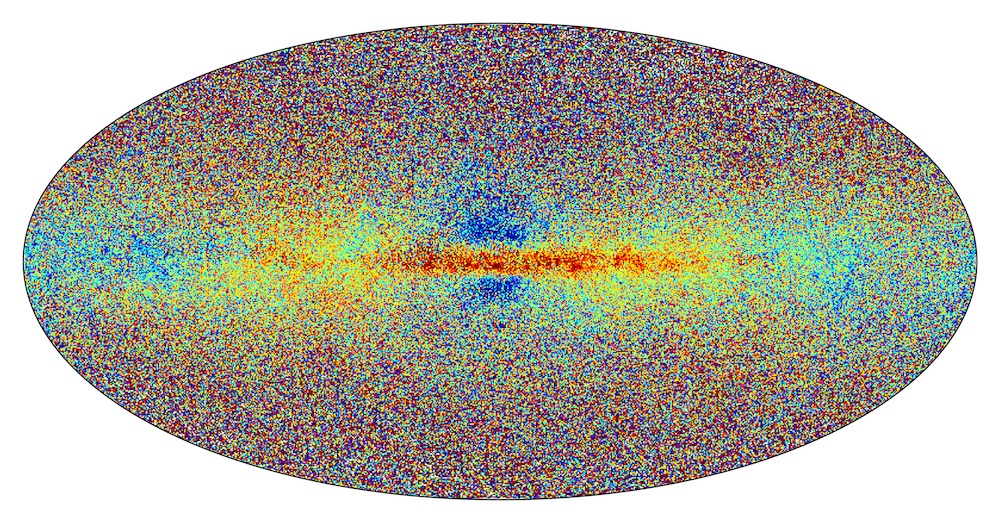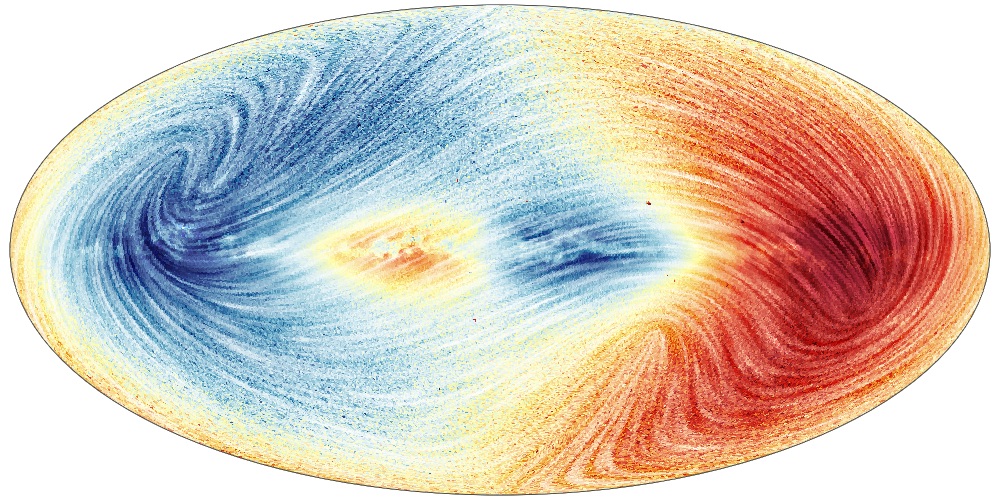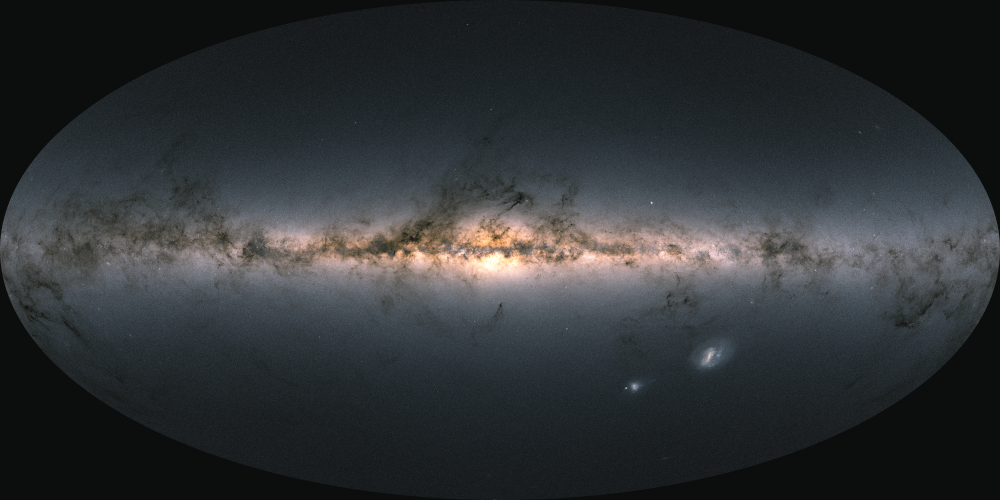IoW_20230613 - Gaia
Image of the Week
Gaia's Multi-dimensional Milky Way
Figure 1. A composition of Gaia sky maps, based on different Gaia data products from Gaia's third data release. Credits: ESA/Gaia/DPAC - CC BY-SA 3.0 IGO. Acknowledgements: created by Tineke Roegiers, based on different Gaia sky maps created by ESA/Gaia/DPAC - CC BY-SA 3.0 IGO and inspired by NASA's Multiwavelength Milky Way Images.
Today marks the first anniversary of Gaia's data release 3 (Gaia DR3). The largest release published by the Gaia Collaboration so far, based on 34 months of data gathered between July 2014 and May 2017. The first batch of data was release already in December 2020, with Gaia's Early Data Release 3 (Gaia EDR3) and on 13 June 2022 the astrometry and photometry was complemented with numerous new data products such as extended objects and non-single stars.
The full Gaia DR3 catalogue consists of data on Milky Way sources, but also contains extragalactic data and information on Solar System Objects. While the large variety of data is hard to capture in a single figure, this composition of Gaia sky maps highlights the multi-dimensional Milky Way information available since last year.
The composition in the figure above was created from several Gaia Collaboration sky maps, as published on 13 June 2022. Below each sky map is provided with short caption and a link to a story discussing the type of data represented in that sky map.
Let's celebrate Gaia DR3's first anniversary!
Gaia' s stellar motion
The trails on this image show the displacement of stars on the sky 400 thousand years into the future. (Image for download, High resolution image for download) Credit: ESA/Gaia/DPAC, CC BY-SA 3.0 IGO. Acknowledgement: The image was created by Anthony Brown, based on an idea from Stefan Jordan, and with inputs from Tineke Roegiers, Xavier Luri, Eduard Masana, and Timo Prusti. Background colour image created by André Moitinho.
More information from the Gaia EDR3 story "Following the journey of stars across the sky" and from the press release of Gaia's Early Data Release 3.
Gaia's stellar ages
Sky map of stellar age obtained for Gaia Data Release 3, showing the average age of the stars in our Galaxy, with blue representing the younger stars and red representing the older stars. Most of the oldest stars are found outside the galactic disk. The age was derived with the Final Luminosity Age Mass Estimator (FLAME). Shown in this map is a random selection of 10 million stars from Gaia DR3. Credits: ESA/Gaia/DPAC - CC BY-SA 3.0 IGO. Acknowledgements: created by O.Creevey, M. Fouesneau, and the Gaia group at MPIA.
More information from the Gaia DR3 story "How big, warm, old, ... are the stars? - Gaia's Stellar parameters".
Gaia's brightnesses
Sky map of G-GRVS. Median G-GRVS colour in HEALpix 7, highlighting the effect of extinction by interstellar dust. GRVS is derived from the integration of the Radial Velocity Spectrometer spectra by the Coordination Unit 6 of DPAC. Credits: ESA/Gaia/DPAC - CC BY-SA 3.0 IGO. Acknowledgements: ESA/Gaia/DPAC/CU6, N. Leclerc, P. Sartoretti and the CU6 team.
More information from the Gaia DR3 story "How bright are the stars? - The Gaia DR3 magnitudes".
Gaia's variable stars
Map in galactic coordinates of about 134,000 RR Lyrae stars for which an estimate of metallicity was obtained from the pulsation period and the φ31 Fourier parameter of the G-band light curve. The sources are colour-coded according to their metallicity ([Fe/H]). The two Magellanic Clouds are easily recognized in the bottom-right portion of the map. The Sagittarius dwarf spheroidal galaxy popping out just below to the left from the centre of the map can also be clearly seen. The higher metallicity of the RR Lyrae stars in the Milky Way bulge compared to variables in the Galactic halo can easily be appreciated, as it is also clear the lower metal abundance of the RR Lyrae stars in the Small Magellanic Cloud compared to the variables in the Large Magellanic Cloud. Credits: ESA/Gaia/DPAC, CC BY-SA 3.0 IGO. Acknowledgements: ESA/Gaia/DPAC/CU7/CU6/CU5/INAF, Gisella Clementini, Alessia Garofalo, Tatiana Muraveva (INAF-OAS Bologna), Vincenzo Ripepi, Roberto Molinaro, Silvio Leccia (INAF-OACn Naples), and the CU7/DPCG, CU5, and CU6 teams.
More information in this Gaia DR3 preview story: "Not only distances: what Gaia DR3 RR Lyrae stars will tell us about our Galaxy and beyond" and in the Gaia DR3 story: "How do they blink? - The dimming and brightening of Gaia's variable stars" and from the press release of Gaia Data Release 3.
Gaia's stellar extinction
Sky map of GSPPhot extinction. GSPphot provides extinction for individual stars. These stars are combined into healpixels at level 10 to create these sky maps. The extinction is shown from A0 = 0 to 4 on the colour bar scale. In Gaia DR2 an extinction map using ~220 million sources binned into level 10 healpixels was shown. In this current map for Gaia DR3 ~470 million sources were used, binned into level 10 healpixels. This sky map has been smoothed. See Andrae et al., 2022 for more details. Note also that the colour map used here is different from that of the GSPphot Gaia DR2 images as published here and here. Details on the data used for this sky map: GSPphot - healpix level 10 data as available from the Gaia Archive. Credits: ESA/Gaia/DPAC - CC BY-SA 3.0 IGO. Acknowledgements: Created by T.E.Dharmawardena, Gaia group @ MPIA
More information from the Gaia DR3 story "What is in between the stars? - Gaia's view on dust and the interstellar medium" and from the press release of Gaia Data Release 3.
Gaia's map of the interstellar medium
This sky map shows the global distribution of the diffuse interstellar bands (DIB) colour coded by the equivalent width of the DIB at HEALPIx level 5 (~1.8 sq degree resolution). We see clearly strong DIBs concentrated towards the galactic plane. Clearly visible are also some extended features towards higher latitudes for the inner Galaxy (|l| < 30 degrees). Credits: ESA/Gaia/DPAC - CC BY-SA 3.0 IGO. Acknowledgements: ESA/Gaia/DPAC/CU8/GSP-SPec, created by H. Zhao and M. Schultheis.
More information from the Gaia DR3 story "What is in between the stars? - Gaia's view on dust and the interstellar medium".
Gaia's radial velocities
Sky map of the Gaia DR3 radial velocities. Download hires version here, without labels here. Compare to the same sky map from Gaia DR2 here. Credits: ESA/Gaia/DPAC- CC BY-SA 3.0 IGO. Acknowledgements: ESA/Gaia/DPAC/CU6, D. Katz, N. Leclerc, P. Sartoretti and the CU6 team.
More information from the Gaia DR3 story: "Do the stars approach us or do they move away? - The Gaia DR3 radial velocities bringing the third velocity component" and from the press release of Gaia Data Release 3.
Gaia's chemical map
All sky view in Galactic coordinates (HEALPix map) showing the stars in the Gaia DR3 GSP-Spec database (Gaia Collaboration, Recio-Blanco et al. 2022). The colour indicates the stellar metallicity, [M/H], that is the mean abundance of all chemical elements except hydrogen and helium. Redder stars are richer in metals. Credits: Gaia Data Release 3: Chemical cartography of the Milky Way by Gaia Collaboration et al. 2022. CC BY-SA 3.0 IGO.
More information from the Gaia DR3 story "What are the stars made of? - A chemical map with Gaia DR3" and from the press release of Gaia Data Release 3.
Gaia's three-dimensional stellar motion map
This sky map illustrates the measurements of the stellar velocities in the Milky Way using data from Gaia. The colour shows the line-of-sight velocity of stars. Blue shows the parts of the sky where the average radial motion of stars, relative to the Sun, is towards us, and red shows the regions of the sky where the average radial motion of stars is away from us. The lines overlaying the map show the streamlines of the proper motions of stars. These lines do not show the transverse motions of the stars in the Milky Way, but illustrate the proper motions as they are published in the catalogue, that is the right ascenscion and declination, projected onto the map in Galactic longitude and latitude. This artistic choice produces the line pattern, including the swirl on the left just above the galactic plane, and the 'peak' a the lower right. The figure is also sensitive to the motion of the Sun within the Galaxy. The LMC and SMC are not visible because stars were selected with well defined distances. The method used to generate the proper motion stream lines follows a modified version of a method from Okada & Kao (1997). The algorithm used was line integral convolution, from healpy. Credits: ESA/Gaia/DPAC - CC BY-SA 3.0 IGO. Acknowledgements: ESA/Gaia/DPAC/CU6, O.N. Snaith, P. Di Matteo, P. Sartoretti, N. Leclerc, D. Katz and the CU6 team. Download hires version here, without labels here.
More information from the Gaia DR3 story: "Do the stars approach us or do they move away? - The Gaia DR3 radial velocities bringing the third velocity component" and from the press release of Gaia Data Release 3.
Gaia's sky in colour
Data from more than 1.8 billion stars has been used to create this map of the entire sky. It shows the total brightness and colour of stars observed by ESA's Gaia satellite and released as part of Gaia's Early Data Release 3 (Gaia EDR3). Credits: ESA/Gaia/DPAC - CC BY-SA 3.0 IGO. Acknowledgements: A. Moitinho.
More information from the image release from the press release of Gaia's Early Data Release 3.
The many dimensions of Gaia Data Release 3
Next to the above sky maps, many more sky maps were published on 13 June 2022 with emphasis on other Gaia data products in the Milky Way but also extragalactic data like quasars and galaxies. A larger selection of sky maps can be found in the below gif.
GIF running through sky maps based on the many different data products from Gaia Data Release 3. Two additional version are available; : without text / 1 sec per sky map and with text. Credits: ESA/Gaia/DPAC, CC BY-SA 3.0 IGO. Acknnowledgements: created by Tineke Roegiers, based on sky maps from the Gaia Collaboration.
More information from the Gaia DR3 stories.
There's a star map waiting in the sky... make sure to go and see it, cuz we think it will blow your minds
There's a star map waiting in the sky... we made sure not to blow it, cuz we know it's so worthwile
So... let the scientists search it... let the scientists use it... let the scientists boogie
Credits: ESA/Gaia/DPAC, T. Roegiers
[Published: 13/06/2023]
Image of the Week Archive

